 |
National Center for Chronic Disease Prevention and Health Promotion
Arthritis
Home | About Us | Contact Us
|
||||||||
National Center for Chronic Disease Prevention and Health Promotion Arthritis Home | About Us | Contact Us |
||||||||
|
|
|||||||||||||||||||||||||||||||||||||||||||||||||||||||
|
|
|
|||||||||||||||||||||||||||||||||||||||
State-specific 2003, 2005 and 2007 BRFSS prevalence estimates
The Behavioral Risk Factor Surveillance System (BRFSS) is the best source for state arthritis prevalence estimates. Read more.
State-specific data:
View the summary of these state-specific 2003, 2005 and 2007 BRFSS prevalence estimates by using the clickable map or the data list below:
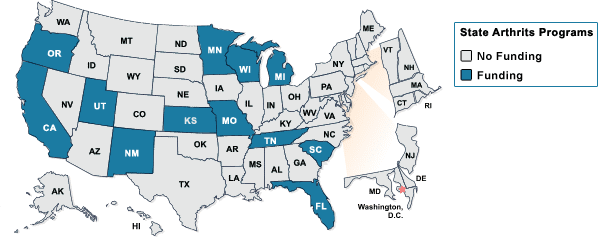
|
Alabama Alaska Arizona Arkansas California Colorado Connecticut Delaware District of Columbia Florida Georgia Hawaii Idaho |
Illinois Indiana Iowa Kansas Kentucky Louisiana Maine Maryland Massachusetts Michigan Minnesota Mississippi Missouri |
Montana Nebraska Nevada New Hampshire New Jersey New Mexico New York North Carolina North Dakota Ohio Oklahoma Oregon Pennsylvania |
Rhode Island South Carolina South Dakota Tennessee Texas Utah Vermont Virginia Washington West Virginia Wisconsin Wyoming |
|
|
|---|
| Guam | Puerto Rico | Virgin Islands |
Arthritis prevalence estimates in women and men by state
In 2005 state-level Behavioral Risk Factor Surveillance System prevalence estimates by sex found women reporting a higher prevalence of arthritis than men in every jurisdiction. When examined by standard prevalence cutoff points (18.0–25.2%; 25.3–28.3%; and 28.4–35.0%), women in only one U.S. state (Hawaii) were in the lowest prevalence group, and men in just two states (Missouri and West Virginia) were in the highest group. In the majority of jurisdictions (32), women were in the highest prevalence group.
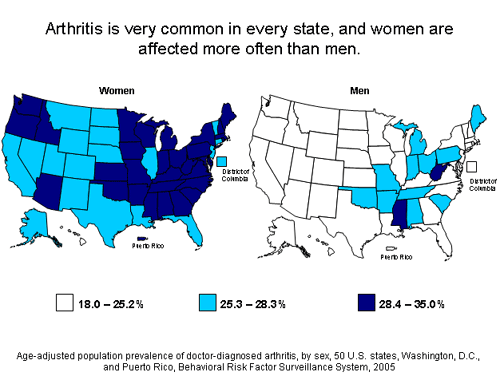
Data Source: BRFFS 2005
Theis KA, Helmick CG, Hootman JM. Arthritis burden and impact are greater among U.S. women than men: intervention opportunities. Journal of Women’s Health 2007;16(4):441–453.
Arthritis prevalence projections through 2030
State-specific projections of arthritis prevalence from 2005 through 2030 show a substantial, average increase of 34% in 50 states. Ten states are anticipated to have increases from 50%–90%, and three states (Arizona, Florida, and Nevada) are projected to see their numbers more than double. Similar increases will occur for arthritis-attributable activity limitation. The biggest projected increases are expected to occur in the “sunbelt” and western states. These projections highlight the need for wider dissemination of existing evidence-based interventions and strategies that have been shown to decrease pain and increase function.
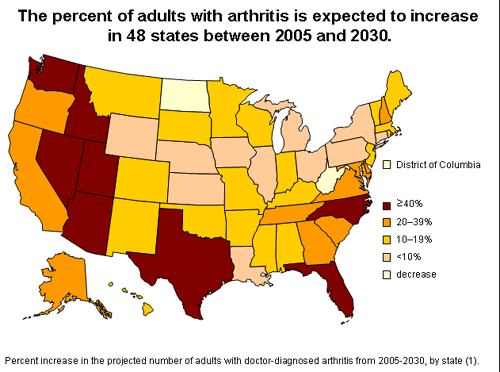
A
table offering more detailed state specific data is available.
Data Source: 2005 Behavioral Risk Factor surveillance system, U.S. Census bureau. http:/www.census.gov/population/www/projections/projectionsagesex.html
Freedman M, Hootman JM, Helmick CG. Projected
state-specific
increases in self-reported doctor-diagnosed arthritis and
arthritis-attributable activity limitations—United States, 2005–2030.
MMWR 2007;56(7):423–425. errata
html,
html,
![]() pdf
(296K)
pdf
(296K)
Prevalence of arthritis-attributable work limitation
In all states, working-age U.S. adults face work limitations they attribute to arthritis. The prevalence of work limitation due to arthritis varies by state but is generally high, affecting from 3.3% to 14.6% of all working-age adults (state median = 6.6%). For example, a state with a population prevalence of arthritis-attributable work limitation of 7% could be expressed as approximately 1 out of every 14 working-age adults in the state report doctor-diagnosed arthritis and say that it limits them in their work.
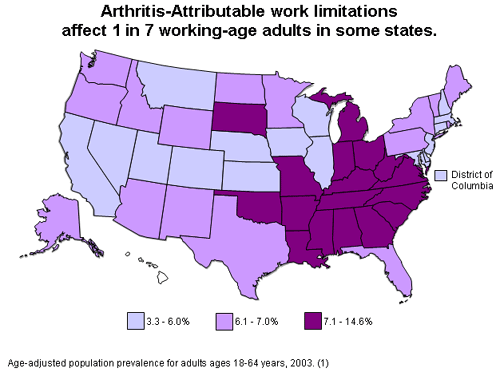
Data Source: BRFFS 2003
Theis KA, Hootman JM, Helmick CG, Murphy L, Bolen J, Langmaid G, Jones GC. State-specific prevalence of arthritis-attributable work limitation—United States, 2003. MMWR 2007;56(40):1045–1049. html pdf (309K)
Proportion of arthritis-attributable work limitation
Arthritis-attributable work limitation is very common among working-age adults with arthritis. In states with the lowest prevalence of work limitations due to arthritis, it is still reported by greater than 1 of every 5 working-age adults with arthritis. In states with the highest prevalence of arthritis-attributable work limitation, that ratio jumps to approximately 1 of every 2 working-age adults with arthritis. The age-adjusted state median is 32.8%, or approximately 1 of 3.
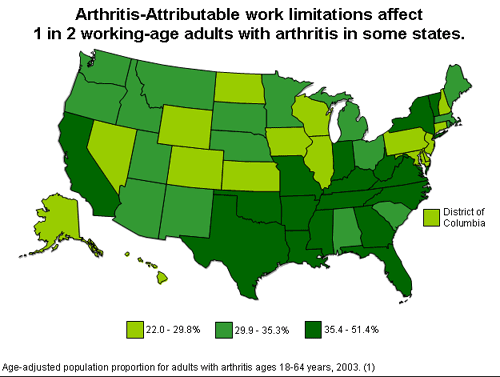
Data Source: BRFFS 2003
Theis KA, Hootman JM, Helmick CG, Murphy L, Bolen J, Langmaid G, Jones GC. State-specific prevalence of arthritis-attributable work limitation—United States, 2003. MMWR 2007;56(40):1045–1049. html pdf (309K)
Arthritis-Attributable activity limitations
The prevalence of adults with arthritis-attributable activity limitation ranges from 6.3% to 16.7% (state median: 9.9%). These high rates of arthritis-attributable activity limitation are projected to increase with the aging of the population (4), requiring increased intervention measures to reduce this impact. Arthritis-attributable activity limitation can be prevented or reduced in many persons. In fact, both aerobic and strengthening exercises can improve physical function and self-reported arthritis disability. Arthritis self-management education classes can also reduce arthritis pain and disability.
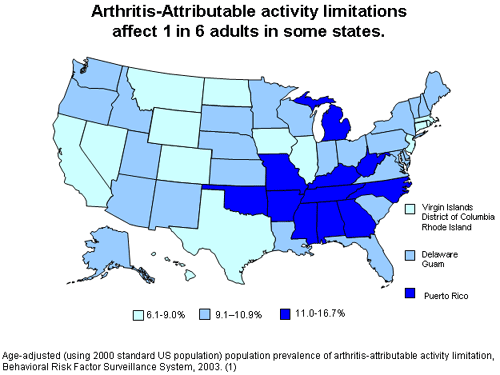
Data Source: BRFFS 2003
Hootman J, Bolen J, Helmick C, Langmaid G. Prevalence of
doctor-diagnosed arthritis and arthritis-attributable activity
limitation—United States, 2003–2005. MMWR [View the errata for this article
here
and here.] 2006;55(40):1089–1092.
html
![]() pdf
(512K)
pdf
(512K)
State Specific Gross Domestic Product (GDP) Estimates
To demonstrate the economic impact of arthritis and other rheumatic conditions (AORC) in each state, this map shows the proportion of each state economy spent on AORC attributable costs relative to the economy of each state. In 2003, costs attributable to AORC represented between 0.3 to 2.6% of each state’s GDP. For example: in 2003, the costs attributable to AORC in West Virginia were $1.2 billion and this represented 2.6% of West Virginia’s GDP.
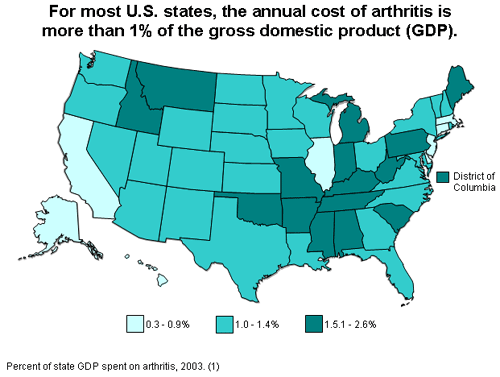
Data Source: BRFFS 2002
Murphy L, Cisternas M, Yelin E, Trupin L,
Helmick C. Update: Direct and indirect costs of arthritis and other
rheumatic conditions—United States, 1997. MMWR
2004;53(18):388–389.
html
![]() pdf (273K)
pdf (273K)
State-Specific 2003, 2005 and 2007 BRFSS prevalence estimates
The Behavioral Risk Factor Surveillance System (BRFSS) is the best source for state arthritis prevalence estimates. BRFSS is a state-based, random-digit-dialed telephone survey of the noninstitutionalized, civilian U.S. population aged > 18 years. The survey is administered in all 50 states, the District of Columbia, Puerto Rico, Guam, and the Virgin Islands. Since 1996, selected states have been collecting information on arthritis through the BRFSS. Starting with the 2003 BRFSS and continuing in odd-numbered years, all states collected information on arthritis. Different questions were used to collect data between 1996–2001 and from 2002 forward. For this reason, it is not valid to look at trends that cross from 2001 into 2002. In 2002, the case definition of arthritis changed as well. Beginning in 2002 we have focused on doctor-diagnosed arthritis only. Read more about the BRFSS arthritis-specific questions and the arthritis case definitions.
![]() Some documents on this page are available in Portable Document Format (PDF). Learn more
about viewing and printing PDF documents with
Acrobat Reader.
Some documents on this page are available in Portable Document Format (PDF). Learn more
about viewing and printing PDF documents with
Acrobat Reader.
Page last reviewed: October 7, 2008
Page last modified: October 7, 2008
Content Source: Division of
Adult and Community Health,
National Center for Chronic Disease Prevention and Health Promotion
|
Privacy
Policy | Accessibility United
States Department of Health and Human Services |